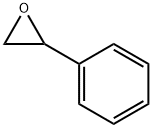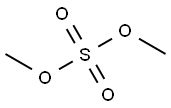
Styrene oxide
- Product NameStyrene oxide
- CAS96-09-3
- CBNumberCB4489359
- MFC8H8O
- MW120.15
- EINECS202-476-7
- MDL NumberMFCD00005121
- MOL File96-09-3.mol
- MSDS FileSDS
Chemical Properties
| Melting point | -37 °C (lit.) |
| Boiling point | 194 °C (lit.) |
| Density | 1.054 g/mL at 25 °C (lit.) |
| vapor density | 4.14 (vs air) |
| vapor pressure | <1 mm Hg ( 20 °C) |
| refractive index | n |
| Flash point | 175 °F |
| storage temp. | Store below +30°C. |
| solubility | 3g/l |
| form | Liquid |
| color | Clear colorless to slightly yellow |
| explosive limit | 1.1-22%(V) |
| biological source | synthetic |
| Water Solubility | 3 g/L (20 ºC) |
| BRN | 108582 |
| Stability | Stability Unstable - polymerises readily with compounds possessing a labile hydrogen (such as acids and alcohols) in the presence of acids, bases or some salts. Combustible. Incompatible with strong oxidizing agents, acids, bases. Moisture sensitive. |
| LogP | 1.61 |
| Indirect Additives used in Food Contact Substances | STYRENE OXIDE |
Safety
| Symbol(GHS) |
 
|
|||||||||
| Signal word | Danger | |||||||||
| Hazard statements | H312-H315-H317-H319-H331-H340-H350 | |||||||||
| Precautionary statements | P201-P280-P302+P352+P312-P304+P340+P311-P305+P351+P338-P308+P313 | |||||||||
| Hazard Codes | T | |||||||||
| Risk Statements | 45-21-36-43-36/38-20/21-46 | |||||||||
| Safety Statements | 53-45-36/37-26 | |||||||||
| RIDADR | UN 2810 6.1/PG 3 | |||||||||
| WGK Germany | 3 | |||||||||
| RTECS | CZ9625000 | |||||||||
| Autoignition Temperature | 928 °F | |||||||||
| TSCA | Yes | |||||||||
| HazardClass | 6.1 | |||||||||
| PackingGroup | III | |||||||||
| HS Code | 29109000 | |||||||||
| Hazardous Substances Data | 96-09-3(Hazardous Substances Data) | |||||||||
| NFPA 704: |
|




